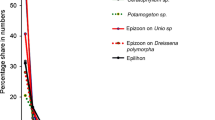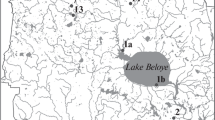Abstract
The research on the spatial distribution of rotifers between the central and border part of the Myriophyllum bed (M. verticillatum) was carried out between 1998 and 1999 in the shallow part (approx. 1 m depth) of Budzyńskie Lake (Wielkopolski National Park, Poland). The comparison of both species composition and the numbers of individuals between both of the examined zones have not revealed statistically significant differences. However, a higher number of rotifer species and their higher densities, as well as increased participation of littoral species were observed in the middle of the vegetation bed. The structure of the dominating species also differed between both areas. Seven rotifer species were found to have significantly greater numbers in the central part of the Myriophyllum bed, while only one species was significantly correlated with the border part of the macrophyte stand. These differences in the behaviour of particular groups of rotifers may be dependent on the structure of their microhabitat and their position in relation to the open water zone. They may also be related to young fish predation in both habitats and better refuge conditions inside the thick macrophyte stand, as well as typical adaptation to littoral or limnetic life.
Similar content being viewed by others
References
Cyr, H. & J. M. Curtis, 1999. Zooplankton community size structure and taxonomic composition affects size-selective grazing in natural communities. Oecologia 118: 306–315.
Cyr, H. & J. A. Downing, 1988a. Empirical relationships of phytomacrofaunal abundance to plant biomass and macrophyte bed characteristics. Can. J. Fish. Aquat. Sci. 45: 976–984.
Cyr, H. & J. A. Downing, 1988b. The abundance of phytophilous invertebrates on different species of submerged macrophytes. Freshwat. Biol. 20: 365–337.
Downing, J. A. & H. Cyr, 1986. Quantitative estimation of epiphytic invertebrate populations. Can. J. Fish. Aquat. Sci. 42: 1570–1579.
Dvorak, J. & E. P. H. Best, 1982. Macro-invertebrate communities associated with the macrophytes of Lake Vechten: structural and functional relationships. Hydrobiologia 95: 115–126.
Folsom, T. C. & N. C. Collins, 1984. The diet and foraging behaviour of the larval dragonfly Anax junius, with an assessment of the role of refuges and prey activity. Oikos 42: 105–113.
Gliwicz, Z. M. & J. I. Rybak, 1976. Zooplankton. In Pieczy?ska, E. (ed.), Selected Problems of Lake Littoral Ecology. Wydanie Uniwersytetu Warszawskiego, Warszawa: 69–96.
Gons, H. J., 1979. Periphyton in Lake Vechten, with emphasis on biomass and production of epiphytic algae. Hydrobiologia. Bull. 13: 116.
Gross, E. M., C; Feldbaum & A; Graf, 2003. Epiphyte biomass and elemental composition on submessed macrophytes in shallow eutrophic lakes. Hydrobiologia 506–509: 559–565.
Jañczak, J., B. Brodzi?ska, A. Kowalik & R. Sziwa, 1996. Atlas of the Lakes of Poland. Bogucki Wydawnictwo Naukowe. Pozna?.
Jeppesen, E., J. P. Jensen, M. Søndergaard, T. Lauridsen, L. J. Pedersen & L. Jensen, 1997. Top-down control in freshwater lakes: the role of nutrient state, submerged macrophytes and water depth. Hydrobiologia 342/343: 151–164.
Jeppesen, E., T. L. Lauridsen, T. Kairesalo & M. R. Perrow, 1998b. Impact of submerged macrophytes on fish-zooplankton interactions in lakes. In Jeppesen, E., Ma. Søndergaard, Mo. Søndergaard & K. Christoffersen (eds), The Structuring Role of Submerged Macrophytes in Lakes. Ecological Studies Series. Springer, New York 131: 91–114.
Jose-de-Paggi, S., 1993. Composition and seasonality of planktonic rotifers in limnetic and littoral regions of a floodplain lake (Parana River system). Rev. Hydrobiol. Trop. 26: 53–63.
Jürgens, K., H. Arndt & K. O. Rothhaupt, 1994. Zooplanktonmediated changes of bacterial community structure. Microbiol. Ecol. 27: 27–42.
Kairesalo, T., I. Tátrai & E. Luokkanen, 1998. Impacts of waterweed (Elodea canadensis Michx) on fish-plankton interactions in the lake littoral. Verh. int. Ver. theor. angew. Limnol. 26: 1846–1851.
Kiss, M. K., G. Lakatos, G. Borics, Z. Gidó & C. Deák, 2003. Littoral macrophyte-periphyton complexes in two Hungarian shallow waters. Hydrobiologia 506–509: 365–372.
Kuczy?ska-Kippen, N., 2001. Struktura przestrzenna zespolów Rotifera w wybranych fitocenozach ro?linno?ci zanurzonej i szuwarowej Jeziora Budzy?skiego (The spatial structure of Rotifera communities of the submerged and rush vegetation phytocoenosis of Budzy?skie lake). PhD thesis, mnsc.
Lauridsen, T. L. & I. Buenk, 1996. Diel changes in the horizontal distribution of zooplankton in the littoral zone of two shallow eutrophic lakes. Arch. Hydrobiol. 137: 161–176.
Lodge, D. M., 1985. Macrophyte-gastropod associations: observations and experiments on macrophyte choice by gastropods. Freshwat. Biol. 15: 695–708.
Makarewicz, J. C. & G. E. Likens, 1975. Niche analysis of a zooplankton community. Science 190: 1000–1003.
Mazzeo, N., Rodriguez-Galleço, C. Rnek, M. Meerhoff, J. Gorga, C. Lazerot, F. Quintans, M. Loureio, D. Larrea & F. García-Rodríguez, 2003. Effect of Egeria densa Planck. beds on a shallow lake without piscivorous fish. Hydrobiologia 506–509: 591–602.
Moore, B. C., W. H. Funk & E. Anderson, 1994. Water quality, fishery and biologic characteristic in a shallow, eutrophic lake with dense macrophyte populations. Lake Reservoir Management 8: 175–188.
Pejler, B., 1995. Relation to habitat in rotifers. Hydrobiologia 313– 314: 267–278.
Phillips, G. L, M. R. Perrow & H. Stansfield, 1996. Manipulating the fish-zooplankton interaction in shallow lakes: a tool for restoration. In Greenstreet, S. P. R. & M. L. Tasker (eds), Aquatic Predators and their Prey. Blackwell Scientific Publications Ltd., Oxford, England: 174–183.
Pip, E. & J. M. Stewart, 1976. The dynamics of two aquatic plantsnail associations. Can. J. Zool. 54: 1192–1205.
Preissler, K., 1977. Do Rotifers show “Avoidance of the shore”? Oecologia (Berlin) 27: 253–260.
Raffaelli, D., S. Hall, C. Emes & B. Manly, 2000. Constraints on body size distributions: an experimental approach using a smallscale system. Oecologia 122: 389–398.
Rybak, J. I., 1960. Rozmieszczenie skorupiaków planktonowych w litoralu i pelagialu ze szczególnym uwzglednieniem granicy miedzy tymi biotopami (The distribution of planktonic crustaceans in the littoral and pelagial, with regard to the border between these biotops). Ekologia Polska (Polish J. Ecol.). A/VIII(6): 133–152.
Scheffer, M., 2001. Ecology of Shallow Lakes. Kluwer Academic Publishers.
Schriver, P. J., E. Bøgestrand, E. Jeppesen & M. Søndergaard, 1995. Impact of submerged macrophytes on fish–zooplankton– phytoplankton interactions: large scale enclosure experiments in a shallow eutrophic lake. Freshwat. Biol. 33: 255–270.
Sheldon, S. P., 1987. The effects of herbivorous snails on submerged macrophytes communities in Minnesota lakes. Ecology 68: 1920–1931.
Stansfield, J. H., M. R. Perrow, L. D. Tench, A. J. D. Jowitt & A. A. L. Taylor, 1997. Submerged macrophytes as refuges for grazing Cladocera against fish predation: observations on seasonal changes in relation to macrophyte cover and predation pressure. Hydrobiologia 342/343: 229–240.
Theil-Nielsen, J. & M. Søndergaard, 1999. Production of epiphytic bacteria and bacterioplankton in three shallow lakes. Oikos 86: 283–292.
Walsh, E. J., 1995. Habitat-specific predation susceptibilities of a littoral rotifer to two invertebrate predators. Hydrobiologia 313– 314: 205–211.
Wegle?ska, T. & J. I. Rybak, 1998. Dobowe migracje horyzontalne skorupiaków planktonowych miedzy skupiskami ro´slin litoralnych a strefa wolnej wody. (Diurnal horizontal migrations of crustaceans between littoral vegetation beds and open water zone). Radwan (ed.). Lublin. UMCS: 117–129.
Winfield, I. J., 1987. The influence of simulated aquatic macrophytes on the zooplankton consumption rate of juvenile roach Rutilus rutilus, rudd Scardinius erythrophthalmus and perch Perca fluviatilis. J. Fish Biol. 29: 37–48.
Wojtal, A., P. Frankiewicz, K. Izidorczyk & M. Zalewski, 2003. Horizontal migration of zooplankton in a littoral zone of the lowland Sulejow Reservoir (Central Poland). Hydrobiologia 506–509: 339–346.
Author information
Authors and Affiliations
Rights and permissions
About this article
Cite this article
Kuczyńska-Kippen, N. The distribution of rotifers (Rotifera) within a single Myriophyllum bed. Hydrobiologia 506, 327–331 (2003). https://doi.org/10.1023/B:HYDR.0000008543.58859.f7
Issue Date:
DOI: https://doi.org/10.1023/B:HYDR.0000008543.58859.f7




